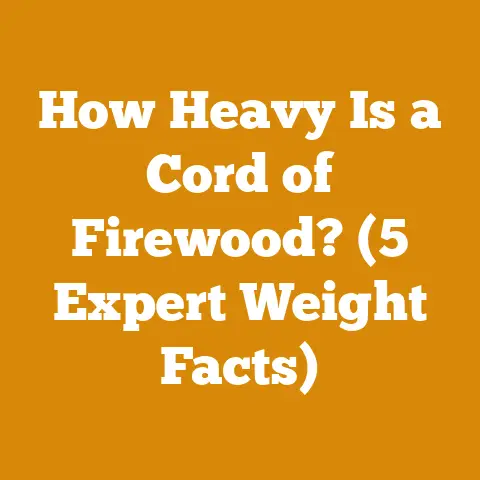How Much Do Pellets Cost for Stoves? (5 Insider Pricing Tips)
Let’s talk about pellet stoves and how to keep your heating costs from going through the roof. Imagine, if you will, the cozy warmth of a wood stove on a chilly winter night. Now, picture the convenience of a thermostat-controlled furnace. That’s the allure of a pellet stove – a blend of rustic charm and modern efficiency. But before you jump on the pellet-burning bandwagon, let’s get real about costs. It’s not always a straightforward calculation, and the price of those little compressed wood cylinders can swing wildly depending on several factors.
How Much Do Pellets Cost for Stoves? (5 Insider Pricing Tips)
For years, I’ve been involved in various aspects of wood processing, from felling trees in the backwoods to splitting and stacking firewood for the winter. I’ve seen firsthand how fuel costs can make or break a budget, whether you’re heating your home, running a small sawmill, or even just enjoying a backyard bonfire.
Unveiling the Pellet Price Puzzle: What Drives the Cost?
The first step in mastering your pellet stove budget is understanding the forces that dictate pellet prices. It’s not just a matter of supply and demand; several intricate factors come into play.
1. Wood Species and Pellet Quality: It’s More Than Just Sawdust
Just like firewood, the type of wood used to make pellets significantly impacts their heating value and, consequently, their price. Hardwood pellets, typically made from oak, maple, or hickory, boast a higher BTU (British Thermal Unit) content than softwood pellets, derived from pine or fir. This translates to more heat per pound, meaning you’ll burn fewer pellets to achieve the same level of warmth.
- Hardwood Pellets: Expect to pay a premium for hardwood pellets, often ranging from \$300 to \$400 per ton. However, their higher BTU content can offset the initial cost in the long run, especially if you’re heating a large space.
- Softwood Pellets: Softwood pellets generally cost less, around \$250 to \$350 per ton. They tend to burn hotter and cleaner but may require more frequent refills due to their lower density.
- Mixed Wood Pellets: These pellets combine hardwood and softwood, offering a balance between price and performance. They usually fall in the \$275 to \$375 per ton range.
Beyond wood species, pellet quality is paramount. Look for pellets certified by the Pellet Fuels Institute (PFI), which ensures they meet specific standards for ash content, moisture content, and BTU value. High-quality pellets burn cleaner, produce less ash, and require less maintenance.
2. Location, Location, Location: Geography’s Impact on Pricing
The cost of pellets can vary drastically depending on your location. Transportation costs play a significant role, as pellets are bulky and expensive to ship long distances. Areas closer to pellet manufacturing plants typically enjoy lower prices.
- Regional Price Differences: In regions with abundant forests and pellet production facilities, such as the Pacific Northwest and the Northeast, prices tend to be lower. Conversely, areas with limited wood resources may face higher prices due to increased transportation costs.
- Urban vs. Rural: Urban areas often have higher prices due to increased demand and higher overhead costs for retailers. Rural areas may offer better deals, especially if you can buy directly from a local producer.
- State-Specific Taxes and Regulations: Some states impose taxes on wood pellets, while others offer incentives or rebates for using renewable energy sources like pellet stoves. These policies can influence the overall cost.
3. Seasonality and Demand: Timing Is Everything
Like many commodities, pellet prices fluctuate with the seasons. Demand peaks during the heating season (typically October to March), driving prices up. Conversely, prices tend to be lower during the off-season (April to September) when demand is low.
- Peak Season Prices: Expect to pay a premium for pellets during the winter months. Retailers often increase prices to capitalize on the increased demand.
- Off-Season Discounts: Take advantage of off-season sales to stock up on pellets at discounted prices. Many retailers offer significant discounts to clear out inventory before the next heating season.
- Early Bird Specials: Some retailers offer early bird specials in the late summer or early fall, allowing you to pre-order pellets at a lower price for delivery later in the season.
4. Bulk vs. Bagged: The Quantity Question
Pellets are typically sold in 40-pound bags or in bulk by the ton. Buying in bulk generally offers a lower price per pound but requires a significant upfront investment and a suitable storage space.
- Bagged Pellets: Bagged pellets are convenient for smaller storage spaces and allow you to buy only what you need. However, they tend to be more expensive per pound than bulk pellets. Expect to pay around \$5 to \$8 per bag, depending on the brand and quality.
- Bulk Pellets: Buying in bulk is the most cost-effective option if you have the space to store a ton or more of pellets. Bulk prices typically range from \$200 to \$350 per ton, depending on the factors mentioned earlier.
- Storage Considerations: Proper storage is crucial for both bagged and bulk pellets. Keep them in a dry, well-ventilated area to prevent moisture absorption, which can reduce their heating value and cause stove problems.
5. Retailer Markup and Competition: Shop Around for the Best Deals
The price of pellets can also vary depending on the retailer. Big box stores, hardware stores, and specialty pellet retailers all have different pricing strategies and overhead costs.
- Compare Prices: Don’t settle for the first price you see. Shop around at different retailers to compare prices and find the best deal.
- Negotiate with Local Dealers: Local pellet dealers may be willing to negotiate prices, especially if you’re buying in bulk or are a repeat customer.
- Consider Online Retailers: Online retailers can sometimes offer lower prices due to lower overhead costs. However, factor in shipping costs when comparing prices.
Beyond the Bag: Hidden Costs of Pellet Stove Heating
While the price of pellets is the most obvious expense, several hidden costs can impact your overall heating budget.
1. Stove Maintenance and Repairs: Keeping Your Stove in Tip-Top Shape
Pellet stoves require regular maintenance to ensure optimal performance and longevity. Neglecting maintenance can lead to costly repairs and reduced efficiency.
- Regular Cleaning: Clean your pellet stove regularly to remove ash and debris, which can clog the burn pot and reduce airflow. This typically involves vacuuming the burn pot, heat exchanger, and exhaust vent.
- Professional Servicing: Schedule a professional servicing at least once a year to inspect and clean the stove thoroughly. This includes checking the auger, blower motor, and safety sensors.
- Repair Costs: Be prepared for potential repair costs. Common issues include auger jams, blower motor failures, and control board malfunctions. Repair costs can range from \$100 to \$500 or more, depending on the issue.
2. Electricity Consumption: Powering the Pellet Stove
Pellet stoves require electricity to operate the auger, blower motor, and control panel. While the electricity consumption is relatively low, it can still add to your overall heating costs.
- Average Electricity Usage: A typical pellet stove consumes between 100 and 300 watts of electricity while operating.
- Calculate Electricity Costs: To estimate your electricity costs, multiply the stove’s wattage by the number of hours it operates per day, then multiply by your electricity rate per kilowatt-hour (kWh).
- Energy-Efficient Models: Consider investing in an energy-efficient pellet stove with features like variable-speed blowers and programmable thermostats to minimize electricity consumption.
3. Installation Costs: Setting Up Your Pellet Stove
If you’re installing a pellet stove for the first time, you’ll need to factor in installation costs. This includes the cost of the stove itself, as well as any necessary modifications to your home.
- Stove Purchase Price: Pellet stoves range in price from \$1,500 to \$5,000 or more, depending on the size, features, and brand.
- Installation Fees: Professional installation typically costs between \$500 and \$1,500, depending on the complexity of the installation.
- Permits and Inspections: Some municipalities require permits and inspections for pellet stove installations. These fees can add to the overall cost.
4. Insurance and Safety: Protecting Your Investment and Your Home
It’s essential to ensure that your pellet stove is properly insured and that you take necessary safety precautions to prevent fires and other hazards.
- Homeowners Insurance: Check with your homeowners insurance provider to ensure that your pellet stove is covered in case of fire or other damage.
- Carbon Monoxide Detectors: Install carbon monoxide detectors in your home to alert you to the presence of this odorless, deadly gas.
- Proper Ventilation: Ensure that your pellet stove is properly vented to the outside to prevent the buildup of carbon monoxide and other harmful gases.
5 Insider Pricing Tips to Slash Your Pellet Stove Costs
Now that you understand the factors that influence pellet prices and the hidden costs of pellet stove heating, let’s explore some practical strategies to save money and keep your heating bills in check.
1. Buy in Bulk During the Off-Season: The Time-Honored Strategy
As mentioned earlier, buying pellets in bulk during the off-season is one of the most effective ways to save money. Retailers often offer significant discounts to clear out inventory before the next heating season.
- Plan Ahead: Start planning your pellet purchases in the late spring or early summer.
- Monitor Prices: Keep an eye on pellet prices at different retailers and wait for the best deals.
- Negotiate with Local Dealers: Don’t be afraid to negotiate with local pellet dealers, especially if you’re buying in bulk.
I remember one year, I scored a fantastic deal on a ton of hardwood pellets in July. The local supplier was clearing out their stock, and I got them for almost \$100 less per ton than I would have paid during the winter. It required some extra storage space, but the savings were well worth it.
2. Source Locally and Cut Out the Middleman: Connecting with Producers
Sourcing pellets directly from a local producer can often save you money by cutting out the retailer’s markup. This also supports local businesses and reduces transportation costs.
- Research Local Producers: Search online for pellet producers in your area.
- Visit Their Facilities: If possible, visit their facilities to inspect the pellets and discuss pricing.
- Negotiate Directly: Negotiate directly with the producer to get the best possible price.
I once met a small-scale pellet producer at a local farmers market. He was selling high-quality hardwood pellets at a fraction of the price of the big box stores. I ended up buying several tons from him over the years, and we developed a great working relationship.
3. Maximize Stove Efficiency and Minimize Waste: Smart Burning Practices
Proper stove maintenance and smart burning practices can significantly improve your pellet stove’s efficiency and reduce pellet consumption.
- Regular Cleaning: Clean your pellet stove regularly to remove ash and debris.
- Proper Ventilation: Ensure that your stove is properly vented to the outside.
- Use a Thermostat: Use a programmable thermostat to maintain a consistent temperature and avoid over-heating.
- Burn High-Quality Pellets: High-quality pellets burn cleaner and produce more heat, reducing pellet consumption.
- Adjust Airflow: Adjust the airflow settings on your stove to optimize combustion.
I learned the importance of proper airflow the hard way. One winter, my stove was burning through pellets like crazy, and I couldn’t figure out why. It turned out that the airflow was restricted due to a clogged exhaust vent. Once I cleaned it out, the stove’s efficiency improved dramatically.
4. Explore Government Rebates and Incentives: Taking Advantage of Savings
Many governments offer rebates and incentives for using renewable energy sources like pellet stoves. These programs can help offset the initial cost of the stove and reduce your overall heating expenses.
- Federal Tax Credits: Check for federal tax credits for energy-efficient appliances.
- State Rebates: Many states offer rebates for pellet stove purchases.
- Local Incentives: Some municipalities offer incentives for using renewable energy sources.
I always make sure to check for available rebates and incentives before making any major purchases, whether it’s a new chainsaw or a pellet stove. It’s free money, and it can make a big difference in your overall budget.
5. Consider Alternative Heating Sources: Diversifying Your Options
While pellet stoves are a great heating option, it’s always wise to consider alternative heating sources, especially during periods of high pellet prices or supply shortages.
- Firewood: If you have access to firewood, consider using a wood stove or fireplace as a backup heating source.
- Propane or Natural Gas: Propane or natural gas heaters can provide supplemental heat during cold snaps.
- Electric Space Heaters: Electric space heaters can be used to heat individual rooms, reducing the need to heat the entire house.
- Passive Solar Heating: Take advantage of passive solar heating by opening curtains and blinds during the day to let sunlight in.
Living in a rural area, I’ve always relied on a combination of heating sources. I use a wood stove as my primary heat source, supplemented by a pellet stove and a propane heater. This allows me to adapt to changing fuel prices and weather conditions.
Case Studies: Real-World Pellet Stove Cost Management
To illustrate the practical application of these pricing tips, let’s examine a few case studies of homeowners who have successfully managed their pellet stove costs.
Case Study 1: The Frugal Family
The Smiths are a family of four living in a small town in Maine. They rely on a pellet stove to heat their home during the winter months. By buying pellets in bulk during the off-season, sourcing locally, and maximizing stove efficiency, they have managed to keep their heating costs below \$1,000 per year.
- Strategy: Bulk buying, local sourcing, stove maintenance.
- Savings: Approximately \$500 per year compared to relying solely on propane heating.
- Key Takeaway: Planning ahead and taking advantage of off-season discounts can significantly reduce heating costs.
Case Study 2: The Eco-Conscious Couple
The Joneses are a retired couple living in Oregon. They are committed to reducing their carbon footprint and rely on a pellet stove as their primary heat source. By investing in an energy-efficient pellet stove, utilizing government rebates, and practicing smart burning habits, they have minimized their environmental impact and kept their heating costs in check.
- Strategy: Energy-efficient stove, government rebates, smart burning.
- Savings: Approximately \$300 per year on electricity and pellet consumption.
- Key Takeaway: Investing in energy-efficient appliances and utilizing government incentives can benefit both your wallet and the environment.
Case Study 3: The DIY Enthusiast
The Millers are a young couple living in Montana. They enjoy tackling home improvement projects and decided to install a pellet stove themselves. By doing their research, obtaining the necessary permits, and following safety guidelines, they saved a significant amount on installation costs.
- Strategy: DIY installation, careful planning, safety precautions.
- Savings: Approximately \$800 on professional installation fees.
- Key Takeaway: With proper planning and research, DIY projects can save you money, but always prioritize safety and follow local regulations.
Budgeting for Pellet Stove Heating: A Step-by-Step Guide
Creating a detailed budget is essential for managing your pellet stove costs effectively. Here’s a step-by-step guide to help you get started:
Step 1: Estimate Your Pellet Consumption
The first step is to estimate how many pellets you’ll need to heat your home for the entire season. This will depend on factors such as the size of your home, the climate in your area, and the efficiency of your stove.
- Calculate BTU Needs: Determine the total BTU needed to heat your home based on square footage and climate zone.
- Stove Efficiency: Factor in your stove’s efficiency rating to determine how many BTUs you’ll get per pound of pellets.
- Estimate Pellet Consumption: Divide your total BTU needs by the BTUs per pound of pellets to estimate your total pellet consumption for the season.
As a rough estimate, a typical home in a cold climate might require 3 to 5 tons of pellets per year.
Step 2: Research Pellet Prices
Once you have an estimate of your pellet consumption, research prices at different retailers and local producers.
- Compare Prices: Compare prices per bag and per ton.
- Factor in Transportation Costs: Consider transportation costs if you’re buying from a distant retailer.
- Negotiate with Local Dealers: Don’t be afraid to negotiate with local dealers to get the best price.
Step 3: Factor in Hidden Costs
Don’t forget to factor in the hidden costs of pellet stove heating, such as maintenance, electricity consumption, and insurance.
- Maintenance Costs: Estimate the cost of regular cleaning and professional servicing.
- Electricity Costs: Calculate your estimated electricity consumption based on your stove’s wattage and your electricity rate.
- Insurance Costs: Check with your homeowners insurance provider to ensure that your stove is covered.
Step 4: Create a Budget
Based on your estimated pellet consumption, pellet prices, and hidden costs, create a detailed budget for your pellet stove heating.
- Pellet Costs: Calculate your total pellet costs based on your estimated consumption and the price per ton or bag.
- Maintenance Costs: Add in your estimated maintenance costs.
- Electricity Costs: Add in your estimated electricity costs.
- Insurance Costs: Add in any additional insurance costs.
Step 5: Track Your Expenses
Throughout the heating season, track your actual expenses to see how they compare to your budget.
- Record Pellet Purchases: Keep track of your pellet purchases, including the date, quantity, and price.
- Monitor Electricity Consumption: Monitor your electricity consumption to see how it compares to your estimate.
- Adjust Your Budget: If necessary, adjust your budget based on your actual expenses.
The Future of Pellet Stove Fuel: Trends and Innovations
The pellet stove industry is constantly evolving, with new technologies and innovations emerging to improve efficiency, reduce emissions, and lower costs.
1. Advanced Combustion Technologies
Manufacturers are developing advanced combustion technologies that burn pellets more efficiently and produce fewer emissions. These technologies include multi-fuel stoves that can burn a variety of biomass fuels, as well as stoves with improved airflow and combustion control systems.
2. Alternative Pellet Fuels
Researchers are exploring alternative pellet fuels made from agricultural waste, such as corn stalks, switchgrass, and wood chips. These fuels could potentially reduce the cost of pellets and provide a sustainable alternative to traditional wood pellets.
3. Smart Stove Technology
Smart stove technology is becoming increasingly popular, with stoves that can be controlled remotely via smartphone apps. These stoves offer features such as programmable thermostats, automatic fuel feeding, and remote diagnostics.
4. Government Regulations and Incentives
Government regulations and incentives are playing an increasingly important role in the pellet stove industry. Regulations are being implemented to reduce emissions and improve efficiency, while incentives are being offered to encourage the use of renewable energy sources.
Conclusion: Mastering Your Pellet Stove Budget
Heating your home with a pellet stove can be a cost-effective and environmentally friendly option, but it’s essential to understand the factors that influence pellet prices and the hidden costs of pellet stove heating. By following the insider pricing tips outlined in this article, you can slash your pellet stove costs, maximize your stove’s efficiency, and enjoy a warm and comfortable home without breaking the bank.
Remember, planning ahead, sourcing locally, maximizing stove efficiency, and taking advantage of government rebates and incentives are all key strategies for managing your pellet stove budget effectively. And don’t be afraid to explore alternative heating sources to diversify your options and adapt to changing fuel prices and weather conditions.
As someone who’s spent years working with wood and understanding the intricacies of fuel costs, I can tell you that knowledge is power. The more you understand about pellet stoves and the factors that influence their costs, the better equipped you’ll be to make informed decisions and save money. So, take the time to do your research, compare prices, and experiment with different strategies. With a little effort, you can master your pellet stove budget and enjoy the warmth and comfort of a pellet stove without emptying your wallet. Now go forth and conquer those heating bills!






